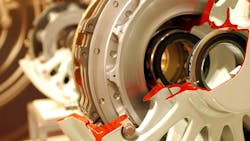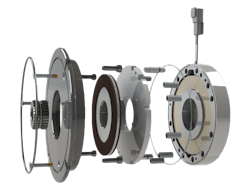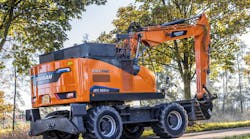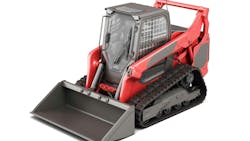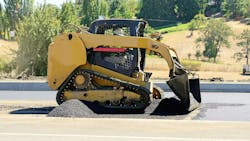Electromagnetic Brakes Aid Construction Industry Transition to Electrification
As the construction industry progresses toward cleaner and more energy efficient operations, implementing incremental changes to the critical components on drive systems can make the largest difference. This includes advancements in braking technology by moving away from hydraulic or pneumatic systems to electromagnetic brakes, a trend that is seen more and more in construction equipment applications.
Electromagnetic brakes operate electrically but transmit torque mechanically. The brakes are engaged by springs and released by a magnet that is excited by an electric current. These brakes do not require any oil or a hydraulic power system (HPU) to operate, making them ideal for high-performance construction equipment.
But what sets these brakes apart from many of the brakes that are typically found on construction equipment?
There are many benefits to choosing electromagnetic brakes over other braking solutions. First, these brakes are silent in comparison to hydraulic brakes during idling, minimizing noise generation when equipment is not operating. Due to the lack of oil needed, these brakes are cleaner, with no risk of oil contamination. They are also safer than traditional brakes, as there is no risk of oil pressure loss. Finally, the compact nature of these brakes allows them to be mounted on the inside of an electric drive, saving space.
In construction machinery where combustion drivetrains are more frequently being replaced by hybrid or electric ones, electromagnetic brakes are a natural fit. These brakes can help minimize carbon emissions and can reduce energy, maintenance, and operational costs. While all of these benefits are significant individually, together they add up to reduced total cost of ownership for the equipment long term, which translates into a substantial win for manufacturers and end users alike.
Shifting from Hydraulic to Electromagnetic Braking Yields Long-Term Benefits
While there is a shift in the construction market towards alternative fuels and electric drivetrains, the velocity of this change remains gradual. With this shift comes the need to take various technology options into account, such as brakes. There are a lot of considerations when comparing a more “traditional” braking technology to an electromagnetic option; it can be difficult to know where to start in terms of adoption and implementation.
Hydraulic brakes have been a staple in construction machinery for decades, known for their reliability and ability to easily handle high torque applications. So, what are some of the factors that might lead a manufacturer to choose electromagnetic brakes?
In the market today, there are electromagnetic braking solutions that can effectively manage high torque in mid-sized machinery, offering comparable performance to traditional hydraulic systems. As the industry shifts to fully electric systems, the need for hydraulics is gradually diminishing, while the space constraints and demands to “do more with less” continue to rise.
Electromagnetic brakes offer an optimal balance of performance and size, and can be easily customized to meet the needs of a wide range of configurations and drivetrain demands, all within a footprint that works for a manufacturer’s machine.
By beginning to implement smaller changes over time, starting with electromagnetic braking systems, you can begin to transition your machinery toward full electrification in a manageable and incremental way. This approach allows you to mitigate the challenges that come with a complete overhaul of your drivetrain at once, such as significant upfront costs, complex integration, and potential for extended production timetables. Gradually integrating these smaller changes can help your business adapt to new technologies, build expertise, and ensure a smoother transition to a fully electric future.
Many compact construction manufacturers have already begun to shift this way, with many others not far behind. As the importance of emissions reduction grows and alternative fuel sources gain popularity in the market, mid- and large-sized equipment manufacturers are also beginning to follow suit. This trend reflects a broader industry movement toward sustainability and innovation, driven by both regulatory pressures and the demand for environmentally friendly solutions.
By adopting these technologies, construction equipment manufacturers and end users are not only reducing their environmental impact but also positioning themselves to meet the evolving needs of the market to stay competitive in the long term.
Read the content below for more insights on developments in electric construction equipment designs.
A Case Study for the Beneficial Impacts of Using Electromagnetic Brakes
A leading manufacturer of compact construction equipment recently took the transformative step to electrify its compact track loaders. While reviewing their drivetrain platforms, two issues became increasingly apparent: their standard electric drivetrain solutions were too bulky, and traditional braking systems fell short of their needs. This manufacturer sought to amplify the power and performance of their machinery while reducing weight and footprint via a compact, electrified system.
By partnering with a global company supplier with intimate knowledge of these applications, the collaboration led to the development of a new electromagnetic brake design. A result of both thoughtful design and deep technical expertise, this brake was crafted to fit within the OEM’s existing drivetrain, while delivering up to 200 Nm of torque in a compact envelope, far surpassing the 70 Nm of torque that is typically seen with these machines. This advancement not only met the OEM’s demands but also laid a foundation for further transitions to energy efficient systems.
Engineered with a dual-voltage coil controlled by Pulse Width Modulation (PWM), the new brake design optimized energy use, extended battery life, and reduced power draw. This innovative design exemplifies a strategic approach to resource management, combining exceptional torque with significantly reduced power consumption. By optimizing the balance between performance and efficiency, this technology not only enhances operational capabilities but also promotes sustainability and cost savings.
The successful integration of the electromagnetic brake not only enabled the OEM’s transition to electric motors but also set a new industry standard with the creation of the first zero-emissions track loader. This new brake is more than just a technical achievement; it is a testament to the transformative power of progress and a solution-oriented approach to real-world challenges.
Innovative designs like this represent the next generation of electric braking technology, paving the way for the industry's shift toward clean and efficient energy solutions. Whether in compact track loaders, forklifts, or agricultural equipment, each integration marks a significant step toward a cleaner, quieter, and more sustainable future.
IoT Connectivity Unlocks Performance Insights and Increases Safety
Electromagnetic brakes, like many other machine components, can be equipped with sensors to monitor their functionality. This enables users to uncover valuable insights and actionable data to keep tabs on their machines remotely when used within a larger Internet of Things (IoT) infrastructure.
Data collected by these sensors can be used with condition monitoring systems on a machine's drive system to help eliminate unplanned downtime which keeps production moving for equipment owners. This is an important option to consider as part of a comprehensive predictive maintenance plan.
Seeing how equipment is performing over time allows end users to plan replacements or maintenance ahead of time, rather than reacting to failures after they occur.
The presence of sensors and monitoring systems also boosts the safety of construction equipment. Ensuring machinery will be functional is essential to protecting both workers and equipment from harm.
As the industry moves toward automation, this built in safety and IoT connectivity will be increasingly important to ensure safe operation as well as allow for remote management of fleets which can be a gamechanger for efficiency.
Utilizing “smart” equipment can not only extend their lifecycle but also improve productivity and save on expenses down the road.
Choosing the Right Supplier Ensures Optimal Braking Technology Selection and Design
Working closely with a component supplier can help construction equipment manufacturers determine the best braking and other technologies are chosen which meet their design requirements. As electrification in the construction industry continues to grow, choosing the right supplier with expertise in developing solutions for electric-powered machines will be increasingly important to ensure optimized designs.
Regal Rexnord, the global supplier mentioned in the aforementioned case study, is a part of the electrification movement taking place within not only the construction industry, but also across a wide range of mobile and outdoor power markets. Its Warner Electric brand is bringing decades of expertise in creating tailored electromagnetic braking solutions to the development of electric drivetrains, helping OEMs to create dependable, reliable and efficient braking technologies capable of meeting their machine and applicaiton requirements.
This article was written and contributed by Jon Volk, Product Manager, Electromagnetic Brakes, Regal Rexnord.
About the Author
Jon Volk
Product Manager, Electromagnetic Brakes
Jon Volk is the Product Manager for Electromagnetic Brakes at Regal Rexnord.
